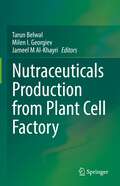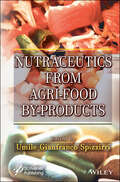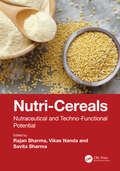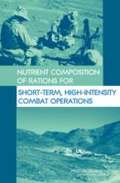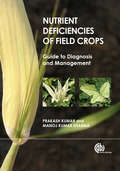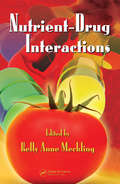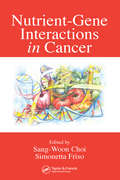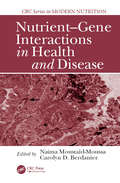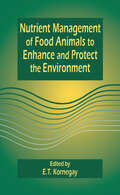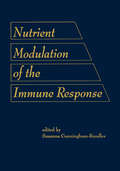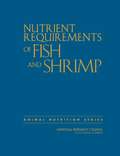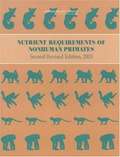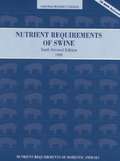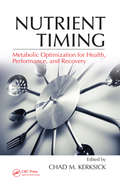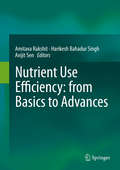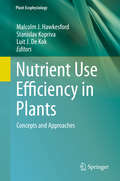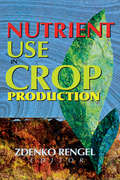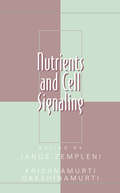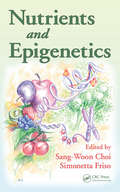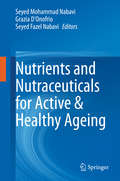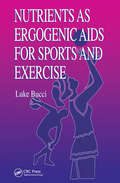- Table View
- List View
Nutraceuticals Production from Plant Cell Factory
by Tarun Belwal Milen I. Georgiev Jameel M Al-KhayriThis book focuses on in vitro techniques and challenges of producing nutraceutical compounds from plant cells. In addition, it provides an overview of different biosynthesis pathways and their modulation through cell culture techniques for the production of nutraceutical compounds in high quantity and quality. It also includes the assessment of the factors influencing production and advances in cell culture techniques, including the scale-up approach using bioreactors. Lastly it provides valuable suggestion for future research.
Nutraceutics from Agri-Food By-Products
by Umile Gianfranco SpizzirriNUTRACEUTICS FROM AGRI-FOOD BY-PRODUCTS This book represents a comprehensive and unique overview covering different aspects (raw materials, technological innovations, and potential applications) concerning waste and by-products of the food industry. Wastes and by-products of the agri-food chain represent a rich source of active molecules that can be usefully employed in the food and pharmaceutical industries. Eco-friendly extraction procedures able to isolate the different components of the agri-food by-products represent an attractive challenge to increase the waste’s value, and, at the same time, solve the issues usually related to their disposal. Each of the 12 chapters in Nutraceutics from Agri-Food By-Products deeply analyses a specific agri-food chain, highlighting the main components recovered in the processing of food, seafood, and dairy wastes and by-products. Specifically, a green approach to the extraction of active molecules is described, as well as the industrial application of agri-food wastes and by-products, and their chemical, physical, and biological properties. Such properties are suitable for use in the food, cosmetic, and pharmaceutical fields. This circular approach could be usefully employed in the industry to develop and commercialize new nutraceuticals and/or functional food that guarantee a considerable increase in the economic worth of the wastes, while producing beneficial effects on human health. Audience Food technologists and biotechnologists in research and industry as well as researchers in pharmaceutical sciences.
Nutri-Cereals: Nutraceutical and Techno-Functional Potential
by Rajan Sharma Vikas Nanda Savita SharmaThe term "Nutri-Cereals" has been dedicated to ten cereals due to their unique nutritional benefits. Nutri-Cereals: Nutraceutical and Techno-Functional Potential covers these cereal grains, with each chapter focusing on nutrient composition and bioactive characterization followed by associated bio-functional properties and health benefits. Further, it covers techno-functionality of nutri-cereals including rheological properties, emulsification and foaming potential, gelation behavior, color profile and others which dictate the suitability of cereals in finished products. Key Features: Covers diverse biological and functional features of nutri-cereals to dictate their potential as functional ingredients in value-added products. Discusses the nutraceutical potential of ten cereals: sorghum, pearl millet, finger millet, foxtail millet, barnyard millet, kodo millet, little millet, proso millet, black wheat and Amaranthus. Explains how these grains are ideal ingredients for gluten free food formulations with enhanced bio- and techno-functional characteristics. Although many of the nutri-cereals have been known for thousands of years, due to their coarse nature and lack of processing they escaped the human diet. Now, thanks to their excellent agro-economic potential and numerous health benefits, they are once again recognized as functional ingredients. Recently, earmarked investment and funding have been observed for valorization of these crops and thus, this book will help academicians to strengthen future investigations.
Nutrient Composition Of Rations For Short-term, High-intensity Combat Operations
by National Research Council of the National AcademiesRecognizing the importance of good nutrition for physical and mental status, the Department of Defense asked the Institute of Medicine to guide the design of the nutritional composition of a ration for soldiers on short-term, high-stress missions. Nutrient Composition of Rations for Short-Term, High-Intensity Combat Operations considers military performance, health concerns, food intake, energy expenditure, physical exercise, and food technology issues. The success of military operations depends to a large extent on the physical and mental status of the individuals involved. Appropriate nutrition during assault missions is a continuous challenge mainly due to diminished appetites of individuals under stress. Many less controllable and unpredictable factors, such as individual preferences and climate, come into play to reduce appetite. In fact, soldiers usually consume about half of the calories needed, leaving them in a state called “negative energy balance.” The consequences of being in negative energy balance while under these circumstances range from weight loss to fatigue to mental impairments. An individual’s physiological and nutritional status can markedly affect one’s ability to maximize performance during missions and may compromise effectiveness. With the number of these missions increasing, the optimization of rations has become a high priority.
Nutrient Deficiencies of Field Crops: Guide to Diagnosis and Management
by Prakash Kumar Manoj Kumar SharmaNutrient imbalance in soils is an emerging threat to sustainable agriculture: intensive cultivation, use of poor quality groundwater, depletion of soil organic matter and excessive use of fertilizers are major reasons for poor soil fertility worldwide. This necessitates correct diagnosis of plant nutrient deficiencies to avoid further use of pesticides in cases where pests or pathogens that are not in fact the cause of poor crop health. Richly illustrated with 600 colour photographs, this book is a visual field identification guide for symptoms of most common nutrient deficiencies in field crops, covering all their stages of occurrence. Detailed descriptions and suggested for management practices are given with each entry.
Nutrient Deficiencies of Field Crops
by Manoj Kumar Sharma Prakash KumarNutrient imbalance in soils is an emerging threat to sustainable agriculture: intensive cultivation, use of poor quality groundwater, depletion of soil organic matter and excessive use of fertilizers are major reasons for poor soil fertility worldwide. This necessitates correct diagnosis of plant nutrient deficiencies to avoid further use of pesticides in cases where pests or pathogens that are not in fact the cause of poor crop health. Richly illustrated with 600 colour photographs, this book is a visual field identification guide for symptoms of most common nutrient deficiencies in field crops, covering all their stages of occurrence. Detailed descriptions and suggested for management practices are given with each entry.
Nutrient-Drug Interactions
by Kelly Anne MecklingCurrent research has given us a more complete understanding of how the chemicals in foods and herbs interact with natural and synthetic drugs. In some cases a single food or supplement can profoundly increase or decrease the toxicity and/or efficacy of a single drug. Although it is standard practice to examine the effects of food consumption on the
Nutrient-Gene Interactions in Cancer
by Sang-Woon Choi Simonetta FrisoThe complete mapping of the human genome, along with the development of sophisticated molecular technologies, has accelerated research on the relationship between nutrients and genes. This has led to compelling evidence garnered from epidemiological and experimental observations supporting the idea that the interaction between nutrients and genes i
Nutrient-Gene Interactions in Health and Disease
by Carolyn D. Berdanier Naima Moustaid-MoussaWe have come to realize that optimal nutrient intake is determined by very specific genetic messages. This realization has led to an entirely new approach to understanding nutrition - the exploration of nutrient effects on gene expression. Edited by leading experts in the field, Nutrient-Gene Interactions in Health and Disease provides an
Nutrient Indicator Models for Determining Biologically Relevant Levels
by Charles Clarence Morris Thomas Paul SimonNutrient Indicator Models for Determining Biologically Relevant Levels: A case study based on the Corn Belt and Northern Great Plain Nutrient Ecoregion is the first book to provide answers to the management of nutrients based on changes in biological communities. The text describes a case study that is the result of a large scale project in the Corn Belt and Great Plains Nutrient Ecoregion. This study is the first to identify relationships between fish assemblages and nutrient concentrations by Nitrogen species. Species optima based on sensitivity and tolerance to nutrients is modeled. Nutrient Biotic indices calibrated for application are based on the results of years of biological indicator development. Test response intervals and Shift response intervals are formulated and validated against relevant biological assemblage shifts. This case study is the first to suggest recommended values for the nitrogen and phosphorus cycle with identifiable shifts caused in biological assemblages. This will provide watershed and environmental managers with the information needed to manage the inputs into the world's dead zones.
Nutrient Interactions
by C.E. BodwellThis book contains the proceedings of the Eleventh Annual Basic Symposium sponsored by the Institute of Food Technologists and the International Union of Food Science and Technology. It discusses nutrition interactions in human and emphasizes research findings from human and animal studies.
Nutrient Management of Food Animals to Enhance and Protect the Environment
by E.T. KornegayNutrient management is an important aspect of feeding livestock and poultry. Today, there is more attention directed toward this issue in animal production than ever before. The heightened awareness of the environmental impacts associated with animal production has caused animal nutritionists to refocus their thoughts, practices, and expectations regarding how nutrients are supplied to animals. In addition, the increase in the size and intensity of modern production units demands new technologies for enhancing nutrient utilization and for reducing the amount of nutrients excreted. Covering these issues and more, Nutrient Management of Food Animals to Enhance and Protect the Environment is a reference tool for agricultural industry leaders, private practitioners, governmental agencies, and researchers.
Nutrient Modulation of the Immune Response
by Susanna Cunningham-RundThis book demonstrates that nutrients play a direct role as co-factors and regulators of the immune system. The book also shows that modulating the immune response with nutrients can provide a fundamental approach to preventive medicine.;Containing nearly 2300 bibliographic citations as well as illustrative figures, tables, and micrographs, this book is designed to be of interest to clinical immunologists, immunology and vitamin researchers, nutrition specialists, paediatricians, neonatologists, and upper-level undergraduate, graduate, and medical school students in these disciplines.
Nutrient Requirements of Fish and Shrimp
by Committee on the Nutrient Requirements of Fish ShrimpAquaculture now supplies half of the seafood and fisheries products consumed worldwide and is gaining international significance as a source of food and income. Future demands for seafood and fisheries products can only be met by expanded aquaculture production. Such production will likely become more intensive and will depend increasingly on nutritious and efficient aquaculture feeds containing ingredients from sustainable sources. To meet this challenge, Nutrient Requirements of Fish and Shrimp provides a comprehensive summary of current knowledge about nutrient requirements of fish and shrimp and supporting nutritional science. This edition incorporates new material and significant updates to information in the 1993 edition. It also examines the practical aspects of feeding of fish and shrimp. Nutrient Requirements of Fish and Shrimp will be a key resource for everyone involved in aquaculture and for others responsible for the feeding and care of fish and shrimp. It will also aid scientists in developing new and improved approaches to satisfy the demands of the growing aquaculture industry.
Nutrient Requirements of Nonhuman Primates: Second Revised Edition, 2003
by Committee on Animal NutritionThis new release presents the wealth of information gleaned about nonhuman primates nutrition since the previous edition was published in 1978. With expanded coverage of natural dietary habits, gastrointestinal anatomy and physiology, and the nutrient needs of species that have been difficult to maintain in captivity, it explores the impact on nutrition of physiological and life-stage considerations: infancy, weaning, immune function, obesity, aging, and more. The committee also discusses issues of environmental enrichment such as opportunities for foraging.Based on the world's scientific literature and input from authoritative sources, the book provides best estimates of nutrient requirements. The volume covers requirements for energy: carbohydrates, including the role of dietary fiber; proteins and amino acids; fats and fatty acids; minerals, fat-soluble and water-soluble vitamins; and water. The book also analyzes the composition of important foods and feed ingredients and offers guidelines on feed processing and diet formulation.
Nutrient Requirements of Swine: Tenth Revised Edition, 1998
by Subcommittee on Swine NutritionThe tenth edition of this essential reference presents new knowledge about the nutritional needs of swine that consider such factors as growth rate, carcass leanness, gender, health, environment, and repartitioning agents. New sections are presented on requirements for amino acids and other nutrients. In addition, an original modeling approach to arriving at energy and amino acid needs for given animals is incorporated in this revision. The book comes with a CD-ROM that allows users to create tables of nutrient requirements for swine of a specific body weight and level of productivity. Nutrient Requirements of Swine covers: Biological concepts that underlie nutrient needs for growth and function. New data on amino acid and energy requirements and the factors that shape them. New findings on lysine and the bioavailability of amino acids. New research results on minerals and vitamins. Nutrient composition of an expanded list of feedstuffs. The role of water in swine physiology, including factors that affect the quality of drinking water. Expanded tables of feed ingredients and their nutrient composition provide bioavailability estimates, fatty acid composition of fats typically used in swine diets, and important information on estimating the amino acid content of crude protein.
Nutrient Timing: Metabolic Optimization for Health, Performance, and Recovery
by Chad M. KerksickSports nutrition has evolved beyond what to eat and how much to eat to now include the question of when to eat. A hot topic in sports nutrition, nutrient timing is a dietary concept that takes into account time as a missing dimension in athletic performance and recovery. Not only is the consumption of nutrients in ideal amounts and proportions impo
Nutrient Use Efficiency: from Basics to Advances
by Avijit Sen Harikesh Bahadur Singh Amitava RakshitThis book addresses in detail multifaceted approaches to boosting nutrient use efficiency (NUE) that are modified by plant interactions with environmental variables and combine physiological, microbial, biotechnological and agronomic aspects. Conveying an in-depth understanding of the topic will spark the development of new cultivars and strains to induce NUE, coupled with best management practices that will immensely benefit agricultural systems, safeguarding their soil, water, and air quality. Written by recognized experts in the field, the book is intended to provide students, scientists and policymakers with essential insights into holistic approaches to NUE, as well as an overview of some successful case studies. In the present understanding of agriculture, NUE represents a question of process optimization in response to the increasing fragility of our natural resources base and threats to food grain security across the globe. Further improving nutrient use efficiency is a prerequisite to reducing production costs, expanding crop acreage into non-competitive marginal lands with low nutrient resources, and preventing environmental contamination. The nutrients most commonly limiting plant growth are N, P, K, S and micronutrients like Fe, Zn, B and Mo. NUE depends on the ability to efficiently take up the nutrient from the soil, but also on transport, storage, mobilization, usage within the plant and the environment. A number of approaches can help us to understand NUE as a whole. One involves adopting best crop management practices that take into account root-induced rhizosphere processes, which play a pivotal role in controlling nutrient dynamics in the soil-plant-atmosphere continuum. New technologies, from basic tools like leaf color charts to sophisticated sensor-based systems and laser land leveling, can reduce the dependency on laboratory assistance and manual labor. Another approach concerns the development of crop plants through genetic manipulations that allow them to take up and assimilate nutrients more efficiently, as well as identifying processes of plant responses to nutrient deficiency stress and exploring natural genetic variation. Though only recently introduced, the ability of microbial inoculants to induce NUE is gaining in importance, as the loss, immobilization, release and availability of nutrients are mediated by soil microbial processes.
Nutrient Use Efficiency in Plants
by Malcolm J. Hawkesford Stanislav Kopriva Luit J. De KokNutrient Use Efficiency in Plants: Concepts and Approaches is the ninth volume in the Plant Ecophysiology series. It presents a broad overview of topics related to improvement of nutrient use efficiency of crops. Nutrient use efficiency (NUE) is a measure of how well plants use the available mineral nutrients. It can be defined as yield (biomass) per unit input (fertilizer, nutrient content). NUE is a complex trait: it depends on the ability to take up the nutrients from the soil, but also on transport, storage, mobilization, usage within the plant, and even on the environment. NUE is of particular interest as a major target for crop improvement. Improvement of NUE is an essential pre-requisite for expansion of crop production into marginal lands with low nutrient availability but also a way to reduce use of inorganic fertilizer.
Nutrient Use in Crop Production
by Zdenko RengelIf you?re an agronomist, horticulturalist, plant and soil scientist, breeder, or soil microbiologist, you?ll want to read Nutrient Use in Crop Production to find everything you need to know about judicious nutrient management and maximizing nutrient utilization in the agricultural landscape. In this book, you?ll discover ways to minimize undesirable nutrient losses and techniques for preserving the environment while meeting the challenges of providing the earth?s increasing population with sufficient food, feed, and fiber to sustain life. Your existing knowledge base concerning this vital area of science will expand and grow as you become more open to the new ideas and applications contained in Nutrient Use in Crop Production. Most importantly, you?ll avoid the narrow scope found in most crop nutrition books and take a broader, more globally minded view of how to maximize nutrient use and minimize nutrient losses in the soil of agricultural systems. Specifically, you?ll find these and other areas covered:population growth, food production, and nutrient requirementsmanaging soil fertility declinethe role of nitrogen fixation in crop productiondelivering fertilizers through seed coatingsmicronutrient fertilizersthe role of nutrient-efficient crops in modern agricultureFeeding the world without depleting the world?s viable soil nutrients is a monumental task--but one that can be achieved, as evidenced in the pages of Nutrient Use in Crop Production. You and your circle of students, professionals, and administrators will benefit greatly from this in-depth view of nutrient use in both developed and non-industrialized counties to give you a better sense of how to allow both the world and the world?s crops to grow.
Nutrients and Cell Signaling
by Janos ZempleniCell signaling is at the core of most biological processes from the simplest to the most complex. In addition to unicellular organisms possessing the essential ability to receive inputs with regard to nutrient availability and noxious stimuli, the cells in multicellular organisms require signaling from adjacent, as well as distant cells to maintain
Nutrients and Epigenetics
by Sang-Woon Choi Simonetta FrisoExplores the Newly Discovered Link Between Nutrition and EpigeneticsCurrent research suggests that nutrients are more than just food components and that certain nutrients can impact the expression of genes that lead to the development of chronic diseases. With contributions from experts in both fields, Nutrients and Epigenetics examines the epigene
Nutrients and Nutraceuticals for Active & Healthy Ageing
by Seyed Mohammad Nabavi Grazia D’Onofrio Seyed Fazel NabaviThis book focuses on the nutrients and nutraceuticals that promote active and healthy ageing – recently defined by the WHO as the process of development and maintenance of functional capacity that allows well-being at an advanced stage of life. There has been a rapid rise in the use of nutritional interventions as well as specific nutraceuticals in the management of multifactorial aspects of clinical health outcomes. Written by leading experts this book comprehensively discusses the various ageing phenotypes and age-related diseases. It also assesses the nutritional status of the elderly and the various epidemiological factors that influence it. It reviews the role of dietary fiber in disease-free and fully functional ageing. Further, the book explores the benefits of polyphenols, which are secondary plant metabolites, in protecting against cancer, cardiovascular diseases, and various neurodegenerative diseases.
Nutrients and Oxidative Stress: Biochemistry Aspects and Pharmacological Insights (SpringerBriefs in Food, Health, and Nutrition)
by Bee Ling Tan Mohd Esa NorhaizanOxidative stress plays a prominent role in the development of numerous human diseases associated with animal-based protein, high-carbohydrate diets and excessive fat consumption. Obesity represents the main risk factor for chronic diseases such as cardiovascular disease, cancer, and type 2 diabetes. Extensive research highlights the detrimental impacts of diets high in saturated fat and refined carbohydrates. Type 2 diabetes, cardiovascular disease and obesity are attributed to the sedentary lifestyles, overconsumption of foods high in saturated fats and carbohydrates, and the saturation of nutrient storage. Indeed, the effects of oxidative stress are associated with the absolute quantity and the type of macronutrients; both of these aspects contribute to oxidative stress and may favor the development of obesity-associated diseases and obesity. Nonetheless, the underlying mechanisms of nutritionally mediated oxidative stress are complex and poorly understood. The literature reported on nutritionally mediated oxidative stress and the role of diets in oxidative stress-induced diseases has not well been compiled in a singular source. “Nutrients and Oxidative Stress: Biochemistry Aspects and Pharmacological Insights” explores how dietary choices dampen or exacerbate inflammation and oxidative stress. The implications of oxidative stress in glucose metabolism and adipocyte and obesity-associated non-communicable diseases are also discussed in this brief. Several issues linked to nutritionally mediated oxidative stress, including high carbohydrates, high animal-based proteins, and excessive consumption of fats and oxidative stress, and molecular mechanisms of oxidative stress-induced diseases are covered. The role of diets in oxidative stress-induced diseases is also discussed. By summarizing all the literature in one place, this work provides a cohesive representation of the information and practical reference on the underlying mechanisms of nutritionally mediated oxidative stress involved in the prevention of chronic diseases. The work provides a better understanding of the nutritionally mediated oxidative stress and the molecular mechanisms of oxidative stress in the development of chronic diseases and obesity.
Nutrients as Ergogenic Aids for Sports and Exercise (Nutrition In Exercise And Sport Ser. #2)
by Luke R. BucciNutrients as Ergogenic Aids for Sports and Exercise discusses the growing body of information regarding the enhancement of human physical performance by dietary manipulations through ergogenesis. It balances the application of nutritional manipulations between overzealous promoters and recalcitrant cynics. By offering a thorough, comprehensive and up-to-date review of what is known about ergogenic effects of nutrients on humans, it bridges the gap between common usage and scientific knowledge. Nutrients as Ergogenic Aids for Sports and Exercise covers in detail many popular product ingredients not considered elsewhere. It illustrates areas awaiting future research, and offers suggestions for avoiding the pitfalls of performing ergogenesis research.
